DJI
DJI Mavic Air: the king of the air
Aprox. 699€ - see price -
See specificationsHow far it seems, the time when DJI was an obscure drone manufacturer who was beginning to venture into the world of cinema and aerial photography! Today the giant of Shenzhen is number 1 in a market where competition is rare, and it is not Mavic Air that will change the trend, quite the contrary.
Positive points
Design.
Performances.
Compactness.
Take it everywhere.
Overall image quality.
Fun flight modes.
Relevant QuickShot modes.
Bad points
Wi-Fi transmission distance limited.
No charge in USB-C.
Limited autonomy.
No lateral obstacle detection.
Full application, but clutter for the beginner.
Our review
Presentation
Last January, from our first handling of the Mavic Air in the South of Spain, we drew the conclusion that DJI had made enormous progress both in style and ease of use. Exit the slightly mashed silhouette of the Phantom 3 and 4: from the Mavic Pro, DJI relies on a "bio design" inspired by nature and insects for better aerodynamics. The Mavic Air is the result and we find on this small body picked up lift supports which increase the stability and the fluidity of flight.
After this first contact, we therefore set out again to face the rigors of a winter much too long to test the quadricopter in real conditions, in the countryside then at the water's edge, and finally to deliver our verdict. No unnecessary suspense: the Mavic Air is simply stunning, and in many aspects. The proof in this test.
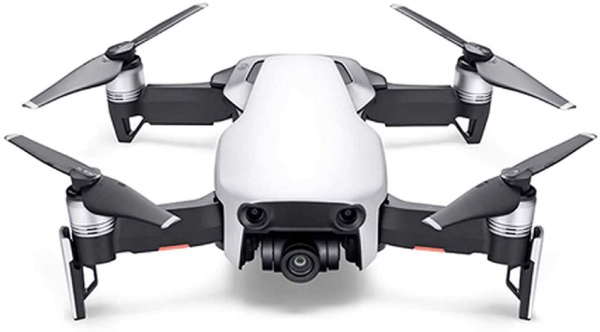
Getting started
So let's start with this reworked design and its compactness. DJI continues its quest for "transportability" and offers the Mavic Air the possibility of folding its four arms to slip everywhere. Even smaller than the Mavic Pro with 168 x 83 x 49 mm folded against 198 x 83 x 83 (L × W × H), the Mavic Air can be stored in any bag or large jacket pocket. To give you an idea, if we compare the Mavic Pro to a reflex without lens, the Mavic Air has the size of a hybrid. The same goes for the tiny radio remote control, of which we appreciate the removable joysticks which further facilitate transport.
Despite its small size, the Mavic Air boasts an impressive technical data sheet, with a 3-axis stabilized gimbal, 4K video, a Sport mode that allows it to point at 68 km / h, flight and Automated shots that reproduce those of Spark ( Helix, Rocket), as well as other various modes (Asteroid, Boomerang, Smart Capture). In addition, we access the Active Track mode which provides detection of several subjects at the same time and above all increased tracking accuracy. Flight Autonomy 2.0 offers obstacle detection up to 20 m thanks to the two pairs of cameras placed on the front and rear of the aircraft.
After many flights, we find that the folding arms system is holding up well over time. We did not notice any assembly faults or excessive play. The same goes for the Wi-Fi antennas housed in the landing gear. On the other hand, the rear hatch protecting the microSD card slot is out of place, with its plastic tab which does not inspire confidence. However, after several weeks of use, the Mavic Air did not suffer from our various treatments.
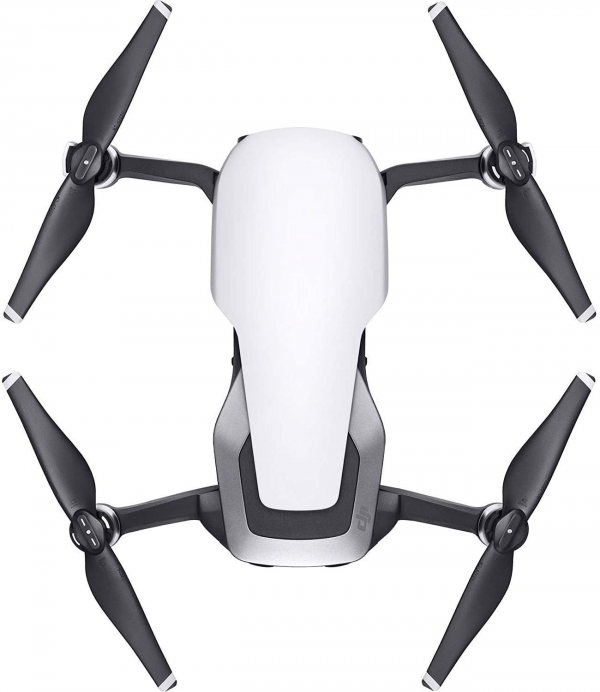
Flight
The Mavic Air follows the same start-up procedure as the other members of its family. First turn on the radio control, unfold the drone like a robot, activate the power-up by double clicking on the battery button, then plug your smartphone into the body of the radio control. The DJI Go 4 application, unchanged, still offers exhaustive and complete menus that will satisfy the advanced amateur but risk losing beginners. Given DJI's desire to target a very large audience, it might have been preferable to operate in stages, by proposing a first approach to full automation, then unlocking functions as you learned. In addition, the messages and other pop-ups necessary for prevention, although useful, end up irritating their prevalence.
If at the time of writing, spring is already far advanced, our first test flights were made in the middle of winter, with negative temperatures and an icy wind. And not to hide anything, we even sent our little Mavic to take a tour of the Himalayas. Except for a particularly chaotic take-off above 5,500 m or even worrying error messages (missing propeller or overheated engine ...) in flight conditions, however classic, the Mavic Air takes off with ease and does not move not. A few fresh gusts of sea wind blow in the engines, but the Mavic Air compensates, struggles and the video feedback shows that stabilization is extremely effective.
Our flight sessions confirmed a noted impression when we first got started: in normal mode, a small latency is felt in piloting. The latter, although reactive, thus marks a slight heaviness in the changes of direction, a little as if the orders were sticking. Same observation in Sport mode; the speeds reached are much higher, but we can feel that the automatic systems take care of the overall heading.
The experience is however very pleasant and the driving very reassuring. By the way, there too, Flight Autonomy 2.0 does a great job of protecting the drone from obstacles. Using a redundancy of sensors and the 7 on-board cameras (including 2 at the rear), the system creates a 3D mapping of the environment in order to detect obstacles and avoid them. Joystick pushed all the way forward, the Mavic Air thus dodges walls and posts. Be careful, however, if you are flying near trees: the obstacle must be sufficiently contrasting and large to be detected. But overall, the flight is fun and easy, especially since the Mavic Air is also controlled via the SmartCapture, that is to say by gestures corresponding to different functions. The function has been improved since Spark and it is easier to take off, go back, advance, film, take photos, etc. ; however, recognition is sometimes still somewhat uncertain.
We appreciate the automated flight modes and the Mavic Air pushes the concept far enough: now, in addition to the famous Helix and Rocket *, * we are entitled to more complex figures, like Asteroid and Boomerang. On this point, there is no criticism to make; we will only have to take care to operate in open ground, and that the drone does not encounter obstacles laterally, since the Mavic Air does not have obstacle detection on the flanks.
Obviously, the trap would be to be satisfied with these automated modes - especially since nothing in our opinion replaces the experience of flying via the radio control -, but undeniably they make the pilot's life easier and, above all, offer interesting points of view much more difficult to obtain when it comes to operating alone and managing the camera axes plus throttle, pitch, roll and yaw.
One point grieves us however: the transmission distance. The Enhanced Wi-Fi system promoted by DJI is supposed to offer up to 4 km of range and 2 km in CE standards. During our various tests, it appeared that the video return suffered from significant latencies from 500 m and became chaotic around 800 m. Under various conditions, the range stops between 800 m and 1,000 m. Beyond that, the absence of video feedback no longer allows you to continue flying serenely; in principle it is annoying, even if in practice the pilot must in any case keep the drone in sight to stay within the framework of the law.
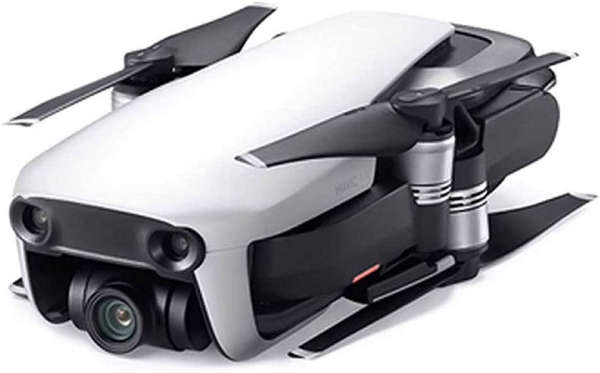
Image quality
All these qualities of flight should not make us forget the primary purpose of Mavic Air: shooting. With its 12MP 1 / 2.3 "Cmos sensor and its 4K 30p video recording capacity, we are on familiar ground. The objective is a 24mm f / 2.8 equivalent. The sensitivity allows you to work from 100 at ISO 3200 in both photo and video, and the electronic shutter manages the exposure time from 8 s to 1/8000 s.
There are many options: there is the possibility of taking single or continuous images up to 7 shots, HDR, exposure bracketing and an interval timer. On the video side, 4K Ultra HD (3,840 x 2,160 px) is available in 24, 25 and 30 fps and it is possible to work up to 60p in 2.7K (2,720 x 1,530 px) and 120p in Full HD (1,920 x 1,080 px) to create slow motion. In addition, the maximum speed is up to 100 MB / s and Jpeg + Raw recording is available.
In photo, the result is consistent with our first impressions, that is to say good; the image is well contrasted and relatively pitted in the center. It is possible to play on adjustment curves to reduce the contrast and saturation, because the rendering is a little too flattering for our taste. But overall, the image quality impresses and is ample enough in our opinion for multiple uses. Obviously, care should be taken not to exceed 200 or even 400 ISO to avoid too much granulation and, above all, a smoothing of the finest details which transforms the trees on the horizon into a flat green. On the other hand, the sharpness on the edges proved to be of good quality and it is only in the angles that the small lens showed its limits.
The Mavic Air has Raw and it will therefore be possible to get the most out of the tiny sensor. If miracles are not to be expected, the room for maneuver in post-processing still allows a lot of information to be recovered.
Finally, with regard to video, the image rendering is there also flattering and contrasting, but less than on the Spark. In Full HD video, the result is correct, even if we feel that the compression does some damage to the details. On the other hand, the result is commendable in 4K 30p: the image is teeming with details and, above all, contrary to what we observe with the Mavic Pro, the rate is not jerky on tracking shots or other camera movements.
In the end, if the image quality of the Mavic Air does not compete with that of the Phantom 4 Pro and its 1-inch sensor, it still defends itself very well, especially given the positioning of the device.
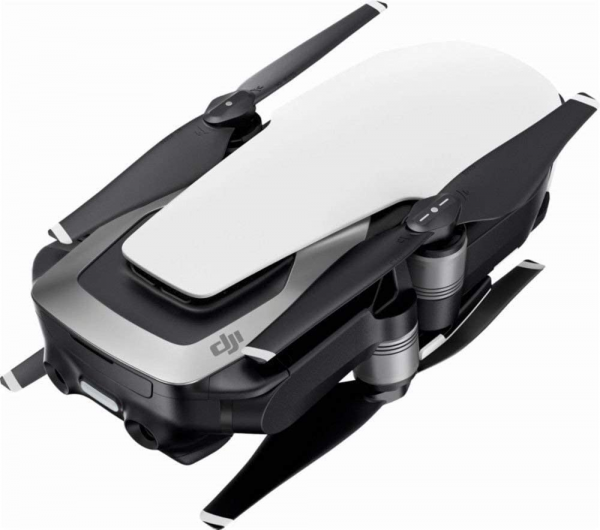
Autonomy
The Mavic Air is equipped with a LiPo 3S type battery of 2,375 mAh and 11.55 V weighing 140 g. It charges in less than an hour, but not via USB-C. The manufacturer promises an autonomy of 21 minutes. In fact, we have repeatedly recorded flights ranging from 16 to 18 minutes; we do not take into account the short flight time obtained at 5,500 m above sea level, these conditions remaining exceptional, but we can still say that this drone has successfully dealt with the elements and the negative temperatures. The Mavic Air is no exception to a rule: to take full advantage of its many capabilities, it is better to take with you at least one or two additional batteries.
Conclusion
The Mavic Air is more than a drone. It offers the user not only the possibility of having fun with its different flight modes, but above all to bring back beautiful images both in video and in photo, and this, in a fun way via relevant QuickShots. We only regret a less efficient Wi-Fi transmission than Ocusync and a little weak autonomy. DJI establishes its supremacy and expertise here. The Mavic Air is a "must-have" that is very easy to recommend.
Specifications
Reviews

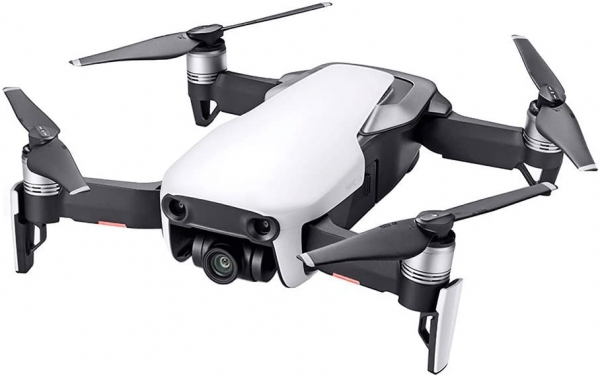
Top quality drone (Great purchase, No regrets) - Tips for potential purchasers
This was an awesome and extremely fun purchase. I've had it now for 2-3 months and have learned a few things that be a helpful to new perspective owners.
This is the Fly More Kit, which differs from the standard drone because it comes with 2 extra lithium batteries and a really nice travel pack, which is designed to hold all of the equipment in one place. In my opinion, its worth the extra money to get the "Fly More Kit" as the batteries only last around 20 minutes each and take a little while to recharge. The "Fly More Kit" gives you an hour of flying time with 3 batteries. Also, the travel bag works well as it keeps all of the parts together and is essentially free for the price.
The drone comes with an internal 8 Gb of storage, but you'll likely want to purchase a memory stick. I bought a Samsung 128GB Evo Plus Class 10 Micro SDXC from Amazon and it worked great with the Drone and my Imac and MacBook flawlessly.
You'll also want to purchase a ND Polarizer filter right away as the footage won't look as good without one. I went a month without the polarizer and wish I would have purchased one right away. This is because there is a ton of light that effects the drone at altitude. Especially if you're shooting around the ocean. I purchased the PolarPro Vivid Collection Filter 3-Pack (ND4 / PL, ND8 / PL, ND16 / PL) Cinema Series for DJI Mavic Air and it is top notch.
Its recommended to shoot in manual mode with the mavic air to get the best video and photos. There is something called the 180 rule, which allows you to set your video settings correctly to get the best picture. However, if you're by the water, you can't adjust the drone to fit within the 180 rule settings without a ND filter.
Pro:
1) Folds up extremely small (Smaller than all other DJI Drones)
2) Relatively easy to learn how to fly
3) Shoots 4K video, has a 28 Megapixel camera
4) This has collision avoidance cameras in the front, bottom and the rear to automatically prevent from colliding with objects. (This is important if you are new to drones to help prevent you from crashing).
5) Top quality design and construction
Cons:
1) The Mavic Air works on a wifi signal and it works pretty well. I was able to fly my drone 5000 feet away, but it does seem to get interference often if you are by a city. Its not overwhelming interference, but it is a slight issue. In comparison, the Mavic Pro has an enhanced communications system that establishes a better / more solid connection with the drone, but the Mavic Pro doesn't fold up as small and is slightly more expensive. This was the biggest difference in my opinion. The Mavic Pro also will maintain a better connection when using "Active Track" due to the enhanced signal.
I hope this helps your research!
DJI beat the desire to drone out of my body...that’s how bad they are!
Got my MA last year (March), great for the first few weeks ... then the nightmare began. If you happen to get a unit that was good off the assembly line you're probably ok, I wasn't that fortunate. I started experiencing connection failures between the bird and the remote which seem to be a pretty common flaw after looking up the issue online and on respective forums, so I communicated with DJI, went through a thousand hoops and procedures and finally got a RMA to ship it back (at my expense) for repair ... got it back and after a couple of weeks -boom- the exact same issue again, but this time DJI wanted to charge me for the 'repair' they didn't get right the first time alleging the drone was damage. I had disclaimed that the drone had a minor incident where the clipped a bush and landed on its back with absolutely no damage to the drone only very minor scrapes on the hull, but that it had work absolutely fine after that. The issue was the exact same issue that had not been resolved in the first place. The seller would not step in to help since he basically claimed -understandably- his relationship with DJI was more important than my issue and Amazon left me standing in the dark with this 1k paperweight because the abc policy (or whatever it's called) had ended a couple of days after. Don't just take my word for it, look around, do your due diligence before handing these people your hard earned. Again, if you get a good bird out the box your probably golden, but if by any chance your encounter the need to deal with DJI customer service, take your meds, it might be a painful ride and learning experience. I love the bird and the whole droning concept, but their customer services' contempt towards their customers is something I thought you wouldn't find on a front like Amazon ... I was wrong.
Absolute Enjoyment
This is written after one week of ownership. I love it. I compared the Mavic Air to the Spark and the Mavic Pro. By most accounts, this was the best of both worlds. As an inexperienced flyer, I can say that this is incredibly easy to fly, the pictures and video are amazing. I have flown in winds up to 20mph and the video looks like it's a still day. The case that comes with this is excellent. it is small and compact and has plenty of space for your accessories. I purchased a hard case though, because it's what i wanted. I've flown approximately 15 times. Each time brings more joy. The controller is comfortable and easy to get used to.
For anyone getting this drone, as a first timer, I would recommend watching some tutorials to prepare. I would also recommend getting an SD card to put in. Make sure you get one that is capable of writing at the speed necessary to write 4k video. (i purchased the SANDISK Extreme)
** Update **
After 3 weeks of ownership, I still feel the same. There is a lot to be said about this drone and it's portability. I keep it with me all of the time. I fly during my lunch breaks, and every day that I can after work. The intelligent flight modes make getting great cinematic shots a breeze. The advertised battery life of each battery is 21 minutes. Don't expect that to be the average. That is a maximum, and when you get to 19 minutes, you're going to be in prayer that it makes it back home to land safely. When flying with caution, you'll actually get closer to 16-18 minutes. This is because once it starts warning you about battery life, you'll bring it home and replace and start again.
My recommendation is for you to stop reading reviews and buy it. You will not regret it.